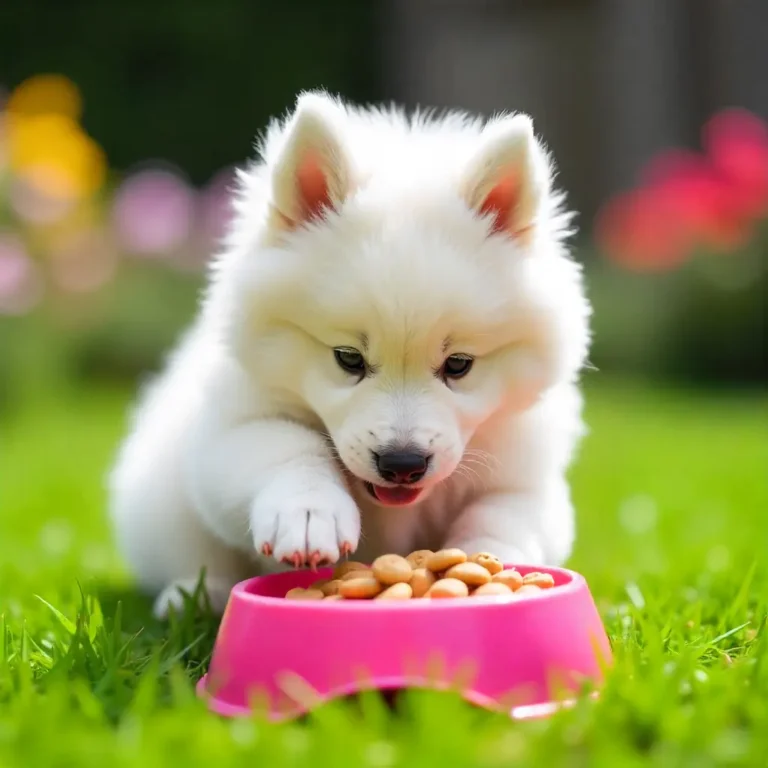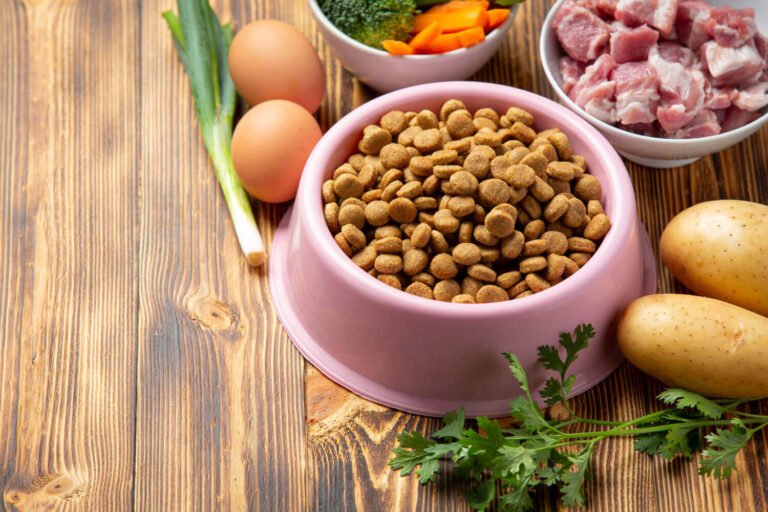Why Pumpkin for Dogs is a Hot Topic in 2025
Most people think of pumpkin as nothing more than a fall flavor—something you see in lattes, pies, and Halloween décor. But here’s the truth: pumpkin isn’t just a seasonal snack for humans. More and more dog owners are discovering that pumpkin for dogs is not a fad, it’s actually a powerful, vet-approved food addition with real health benefits.
So, why is everyone searching “is pumpkin good for dogs” in 2025? Because pet parents are tired of confusing nutrition advice, expensive supplements, and over-processed dog treats. Instead, they want simple, natural foods that keep their pups healthy—and pumpkin checks all those boxes.
This pumpkin guide for dogs 2025 is here to give you straight answers. You’ll learn:
Why pumpkin is unique for dogs
The nutritional benefits of pumpkin (fiber, vitamins, antioxidants, and more)
The difference between fresh pumpkin for dogs and canned pumpkin for dogs
How much pumpkin is safe to feed
Risks to watch out for
And vet-approved tips to get the most out of this orange superfood
In short, by the end of this guide you’ll know exactly whether pumpkin belongs in your dog’s bowl (spoiler: it probably does—but with a few important rules).
Pumpkin is one of the most popular dog food ingredients due to its digestive benefits.
What Makes Pumpkin for Dogs So Special?
If you’ve ever wondered why vets, trainers, and even holistic pet experts keep recommending pumpkin, the answer is simple: it’s a nutrient powerhouse packed into one humble vegetable. Let’s break it down.
Nutritional Breakdown of Pumpkin for Dogs
Pumpkin is naturally rich in:
Fiber – This is the big one. Fiber in pumpkin helps regulate digestion, easing both diarrhea and constipation. That’s why you’ll often hear vets suggest a spoonful of canned pumpkin when your pup’s tummy is upset.
Vitamins A, C, and E – Vitamin A supports eye and skin health, vitamin C boosts immunity, and vitamin E is a natural antioxidant that protects cells.
Minerals like potassium and iron – Potassium supports muscle function and hydration, while iron helps maintain healthy red blood cells.
Antioxidants and beta-carotene – These protect your dog’s body from free radicals and keep their coat shiny.
When you put this together, you get a natural food that supports digestion, immunity, energy, skin, and coat—all without artificial additives. That’s why so many pet owners are switching to pumpkin in dog food or adding it as a supplement.
Why Vets Recommend Pumpkin for Dogs
Ask any vet: pumpkin is one of the simplest, safest “people foods” you can share with your pup. Unlike trendy supplements, pumpkin is affordable, widely available, and proven to help with common issues like digestive upset. Vets often recommend it for:
Dogs with sensitive stomachs
Picky eaters who need a nutritional boost
Overweight dogs (since pumpkin adds fiber without excess calories)
Dogs prone to constipation or loose stools
In other words, pumpkin isn’t just a home remedy—it’s a vet-backed food addition that works.
Pumpkin is also a great addition to special diets for dogs with sensitive stomachs.
Fresh Pumpkin vs. Canned Pumpkin for Dogs
Here’s where most owners get confused: should you feed fresh pumpkin or stick with canned pumpkin for dogs?
Fresh pumpkin (steamed or baked, no seasonings) is fantastic if you want all-natural nutrition. It’s packed with fiber and vitamins, but it takes time to prep and doesn’t store well.
Canned pumpkin (plain, 100% pumpkin—not pie filling) is the go-to for most pet parents. It’s quick, shelf-stable, and has the same digestive benefits as fresh pumpkin.
Important tip: Avoid pumpkin pie filling at all costs—it contains sugar, spices, and sometimes xylitol, which is toxic to dogs. Always choose pure pumpkin.
So, whether you grab a fresh pumpkin at the farmer’s market or a can from the grocery store, both are safe and healthy. Just remember: moderation is key.
11 Amazing Benefits of Pumpkin for Dogs
Most people think of pumpkin as a fall decoration or a sweet pie filling, but when it comes to dogs, it’s so much more. Pumpkin for dogs isn’t just hype—it’s genuinely packed with health benefits that can make a big difference in your pup’s daily life. Let’s break down the top 11 reasons vets and pet parents are adding pumpkin to dog diets in 2025.
1. Pumpkin for Digestion & Constipation Relief
If your dog struggles with constipation, pumpkin is one of the simplest natural remedies you can try. Thanks to its high fiber content, pumpkin works as a gentle digestive regulator. Just a spoonful of plain canned pumpkin can get your dog’s bowels moving without harsh chemicals.
2. Pumpkin for Dogs with Diarrhea
Surprisingly, pumpkin helps with the opposite problem too—diarrhea. Its soluble fiber absorbs excess water in your dog’s stool, making it firmer. That’s why pumpkin is one of the first vet-approved home remedies for runny poop.
3. Weight Loss Aid: Pumpkin for Overweight Dogs
Dog obesity is a rising problem in 2025. Pumpkin offers a low-calorie, nutrient-rich filler that helps dogs feel full without adding extra pounds. Replacing a portion of kibble with pumpkin can support healthy weight management.
4. Pumpkin Seeds as a Natural Dewormer
Did you know pumpkin seeds contain a compound called cucurbitacin that paralyzes intestinal worms? Many holistic vets recommend raw, unsalted pumpkin seeds as a natural dewormer. You can grind them up and mix with your dog’s food.
5. Pumpkin for Healthy Skin & Shiny Coat
Pumpkin is loaded with essential fatty acids, vitamin A, and zinc—nutrients that directly support skin health and coat shine. If your dog has dry skin or a dull coat, adding pumpkin to their diet may help restore that healthy glow.
6. Boosts Immune System in Dogs
Pumpkin is rich in antioxidants like beta-carotene and vitamins C and E. These nutrients support a strong immune system, helping your pup fight off infections and stay healthier overall.
7. Pumpkin for Dogs with Allergies & Sensitive Stomach
Many dogs suffer from food allergies or sensitive digestion. Pumpkin is a gentle, hypoallergenic food that soothes the stomach. Its anti-inflammatory properties can also reduce irritation from certain allergens.
8. Pumpkin for Joint Health & Mobility
Older dogs or large breeds often face joint stiffness. Pumpkin’s beta-carotene and anti-inflammatory nutrients can support joint health and mobility. While not a cure, it works well as a natural supplement alongside vet care.
9 Hydration Benefits (Pumpkin is Water-Rich)
Pumpkin is about 90% water, making it a great way to keep dogs hydrated—especially during hot months or if your dog doesn’t drink enough water. Hydration is key for kidney and urinary tract health.
10. Pumpkin for Dogs with Diabetes (Low-Calorie Treat Option)
Dogs with diabetes need treats that are low in sugar and calories. Pumpkin is naturally sweet yet safe in moderation, making it a vet-approved snack for diabetic dogs.
11. Mental & Emotional Health: Comfort Food for Dogs
Just like humans, dogs sometimes benefit from comfort foods. Pumpkin’s natural taste and texture can have a calming effect. Some pet parents use pumpkin as a positive reinforcement treat during stressful times.
Quick Recap: Pumpkin for dogs isn’t just a trendy superfood—it genuinely supports digestion, weight, skin, immunity, joints, hydration, and even emotional health. No wonder it’s one of the most talked-about natural foods for dogs in 2025.
Risks of Feeding Pumpkin to Dogs
Most pet parents hear about the benefits of pumpkin and think, “Well, if it’s healthy, I can give my dog as much as I want.”
That’s the biggest misconception. While pumpkin is super healthy, too much of a good thing can actually backfire.
Can Pumpkin Be Bad for Dogs?
Yes — pumpkin can be bad for dogs if it’s overfed or given in the wrong form. The flesh itself isn’t harmful, but dogs don’t need huge amounts every day. When served excessively, pumpkin can upset your pup’s stomach instead of helping it.
Overfeeding Risks: When Too Much Pumpkin Becomes a Problem
Pumpkin is packed with fiber. A little helps digestion, but too much leads to:
Loose stools or diarrhea (ironically the opposite of what you wanted)
Nutrient imbalance if pumpkin replaces too much of your dog’s regular food
Tummy discomfort like gas and bloating
Think of pumpkin as a healthy supplement, not a full meal replacement. Moderation is key.
Not All Pumpkin Is Safe for Dogs
Here’s where many owners make mistakes. Not every pumpkin product on store shelves is dog-friendly:
Pumpkin pie filling – usually loaded with sugar, nutmeg, cinnamon, or xylitol (toxic for dogs).
Spiced pumpkin products – dogs can’t tolerate the same spices we do.
Raw pumpkin skin or stem – tough, hard to digest, and can cause choking or blockage.
The only safe options are plain cooked pumpkin or pure canned pumpkin with no additives.
When Pumpkin Might Not Help
Pumpkin is amazing for mild tummy troubles, but it’s not a cure-all. Sometimes it won’t help, and in fact, you might delay proper treatment by relying on it.
Chronic diarrhea → could be parasites, IBD, or other conditions that need a vet.
Pancreatitis → pumpkin won’t soothe this; a special diet is required.
Severe constipation → too much pumpkin could worsen the blockage.
If your dog’s symptoms last more than 24–48 hours, skip the DIY remedies and call your vet.
Quick takeaway: Pumpkin is safe and healthy — but only when fed in the right form and the right amount. Stick to plain cooked or canned pumpkin, avoid the fancy pie mixes, and use it as an occasional supplement, not a meal replacement.
How Much Pumpkin Should I Feed My Dog?
Pumpkin is healthy, but the right dosage matters. Too little might not help, and too much could upset your pup’s stomach. While pumpkin helps digestion, knowing how much to feed your dog is key. So, let’s break it down into vet-approved serving sizes and tips.
Vet-Approved Serving Sizes by Dog Weight
Here’s a general guideline vets recommend for plain canned or cooked pumpkin (no spices, no sugar):
Small dogs (under 20 lbs): 1–2 teaspoons per meal
Medium dogs (20–50 lbs): 1–2 tablespoons per meal
Large dogs (50+ lbs): 2–5 tablespoons per meal
Always start small and watch your dog’s reaction before increasing.
Daily Frequency: Snack vs Meal Topper
As a snack: Mix pumpkin into a little spoonful for a healthy treat.
As a meal topper: Add to kibble or wet food for fiber and nutrients.
Don’t replace more than 10% of your dog’s daily food with pumpkin.
Think of it as a supplement, not the main course.
How Fast Does Pumpkin Work for Dogs?
Many pet parents ask: “How long does it take for pumpkin to work in dogs?”
For constipation or diarrhea, you may see improvement in 12–24 hours.
For weight loss or skin/coat benefits, it may take a few weeks of consistent feeding.
Pumpkin for Puppies, Adults & Seniors
Puppies: Safe in small amounts (½–1 teaspoon), but always introduce slowly — their digestive systems are sensitive.
Adult dogs: Can enjoy the standard serving sizes above.
Senior dogs: Pumpkin is great for digestion and joint support, but check with your vet if your senior has health conditions (like kidney issues).
Quick takeaway:
Start with small amounts, adjust by your dog’s weight, and don’t exceed 10% of their diet. Pumpkin usually helps within a day for digestion, but long-term benefits show with consistent, moderate use.
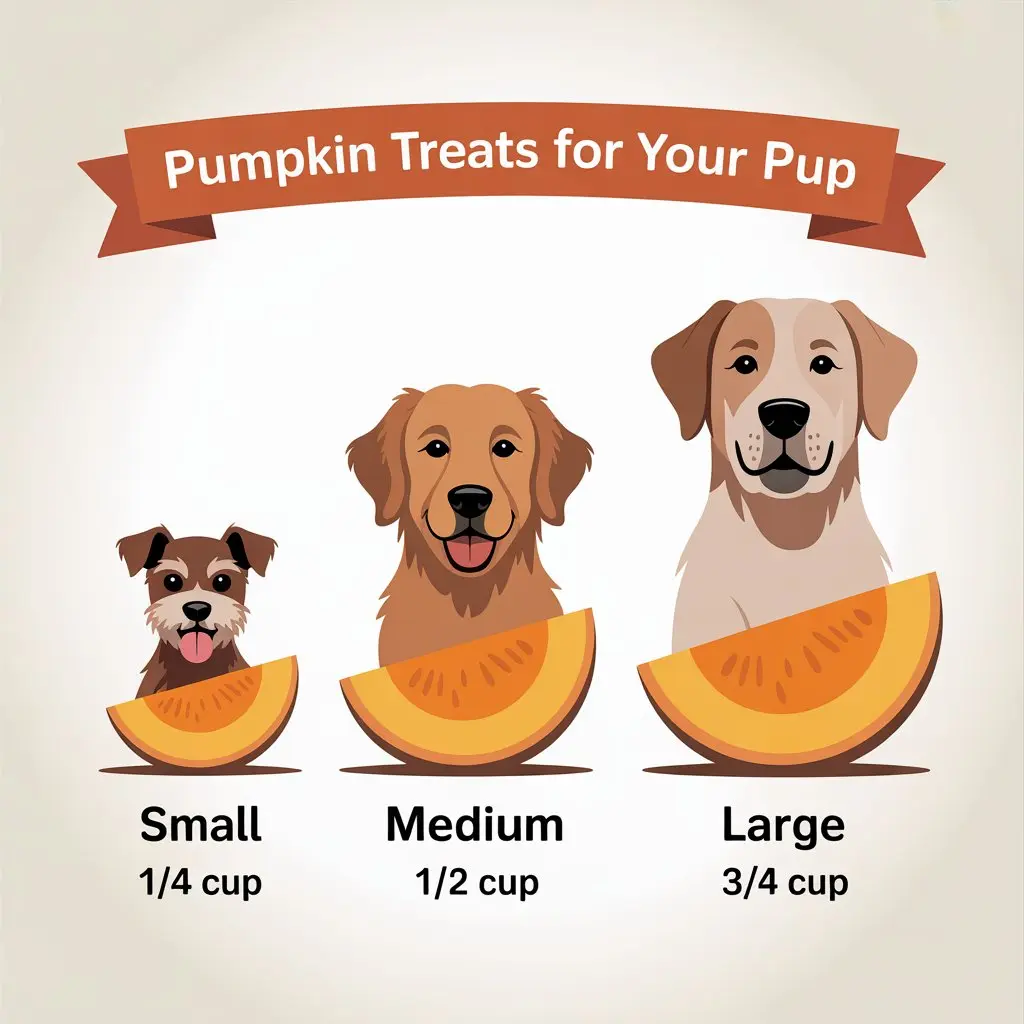
Fresh vs Canned Pumpkin for Dogs – Which is Better?
Both fresh pumpkin and canned pumpkin can be safe, healthy options for dogs — but each has unique benefits. Here’s what you should know before scooping it into your pup’s bowl.
Benefits of Fresh Cooked Pumpkin
High in nutrients: Fresh pumpkin contains natural vitamins A, C, and E, plus antioxidants that support immunity.
Water-rich: Helps keep your dog hydrated (especially useful for pups who don’t drink much water).
Fiber boost: Gently cooked pumpkin provides natural soluble fiber for digestion.
Homemade control: You know exactly what’s inside — no risk of hidden additives.
Just remember to cook it (boiled, steamed, or baked), and remove skin and seeds unless using seeds separately.
Benefits of Pure Canned Pumpkin (No Additives)
Convenience: Shelf-stable, easy to store, and quick to use.
Consistent texture & fiber: Great for digestive issues like constipation or diarrhea.
Year-round availability: No need to wait for pumpkin season.
Look for 100% pure pumpkin — nothing added. Avoid pumpkin pie filling (it often has sugar, spices, or nutmeg, which are toxic to dogs).
Avoid feeding dogs pumpkin pie filling, which contains sugar and spices unsafe for pets. The ASPCA highlights ingredients like nutmeg as toxic to dogs.
Is Libby’s Canned Pumpkin Safe for Dogs?
Yes! Libby’s 100% Pure Pumpkin (the one in the orange can, not pie mix) is one of the most recommended brands by vets and pet parents. It contains only pumpkin, making it safe and reliable.
Experts at Tufts University Veterinary Nutrition recommend using plain, canned pumpkin with no additives for the safest results.
Frozen Pumpkin Cubes for Summer Treats
Want a fun twist? Freeze pure pumpkin into ice cube trays for a refreshing summer snack.
Helps cool your dog down.
Adds hydration.
Perfect portion control (just pop out a cube or two).
Quick takeaway:
Fresh pumpkin = nutrient-rich & homemade goodness.
Canned pumpkin = convenient & consistent.
Both are safe — just avoid pumpkin pie filling.
Libby’s 100% pure pumpkin is a vet-approved option.
Frozen pumpkin cubes make a healthy treat hack.
Fresh vs Canned vs Frozen Pumpkin for Dogs – Quick Comparison
| Type of Pumpkin | Pros | Cons | Best For |
|---|---|---|---|
| Fresh Cooked Pumpkin | – Rich in natural vitamins & antioxidants – High water content (hydration) – Homemade, no additives | – Requires cooking/prep – Short shelf life | Dogs with sensitive stomachs, hydration boost |
| Canned Pumpkin (100% Pure, e.g., Libby’s) | – Convenient & shelf-stable – Consistent fiber for digestion – Available year-round | – Must avoid pie filling (toxic) – Slightly less water content than fresh | Dogs with constipation, diarrhea, picky eaters |
| Frozen Pumpkin Cubes | – Fun summer treat – Easy portion control – Hydrating & cooling | – Needs freezer storage – Messy if melts indoors | Overheated dogs, snack variety, portion control |
Quick Vet Tip: Always start with small servings and adjust based on your dog’s size and reaction.
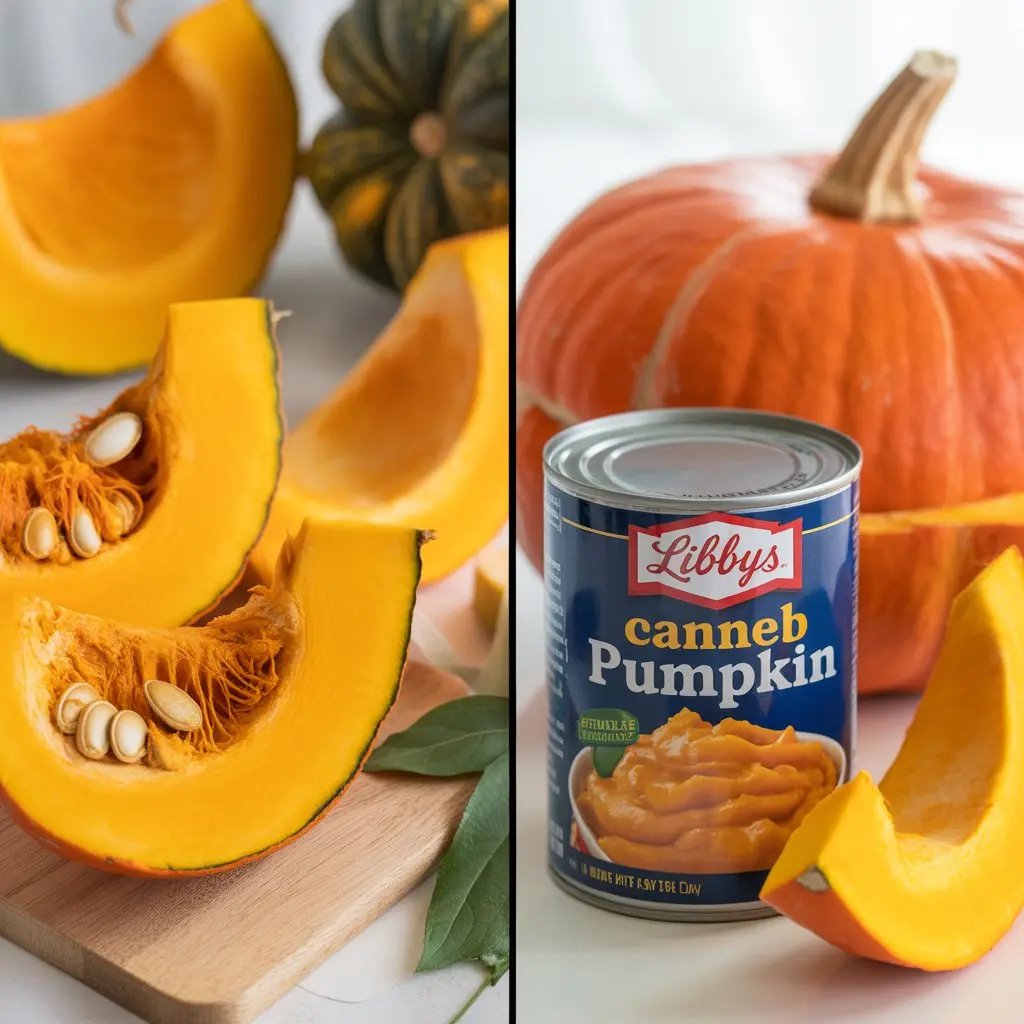
Pumpkin Seeds for Dogs
Pumpkin seeds aren’t just a crunchy snack for humans — they’re also a nutrient-packed superfood for dogs when given in the right way. Here’s why (and how) to add them safely.
Pumpkin seeds aren’t just a crunchy snack for humans — they’re also a nutrient-packed superfood for dogs when given in the right way. Here’s why (and how) to add them safely.
Nutritional Benefits of Pumpkin Seeds
Rich in zinc & magnesium → supports immune health, metabolism, and strong bones.
Plant-based protein → helps maintain lean muscle.
Healthy fats & antioxidants → contribute to skin and coat health.
Vitamin E & iron → boost energy and overall vitality.
Natural Deworming Properties
Pumpkin seeds contain cucurbitacin, an amino acid compound that can help paralyze and expel intestinal worms in dogs naturally.
Often recommended as a gentle home remedy for mild worm issues.
Not a replacement for prescribed dewormers in severe cases — always check with your vet.
How to Prepare Pumpkin Seeds Safely
Not all pumpkin seeds are dog-friendly straight from the bag. Follow these safe prep tips:
Always peel → Dogs digest shelled seeds more easily.
Roasted vs raw → Both are safe, but light roasting brings out flavor (avoid oils & seasonings).
Unsalted only → Salt, sugar, and spices can harm your pup.
Grind or crush → Makes it easier to mix into food and digest.
Serving Sizes for Dogs
Like all treats, moderation is key.
Small dogs: 2–3 seeds a day
Medium dogs: 5–10 seeds a day
Large dogs: up to 10–20 seeds a day
Can also sprinkle ground pumpkin seeds over meals for easier feeding.
Quick takeaway:
Pumpkin seeds are safe, nutritious, and can even help naturally fight worms — as long as they’re peeled, plain, and given in moderation.
Vet-Approved Ways to Feed Pumpkin to Dogs
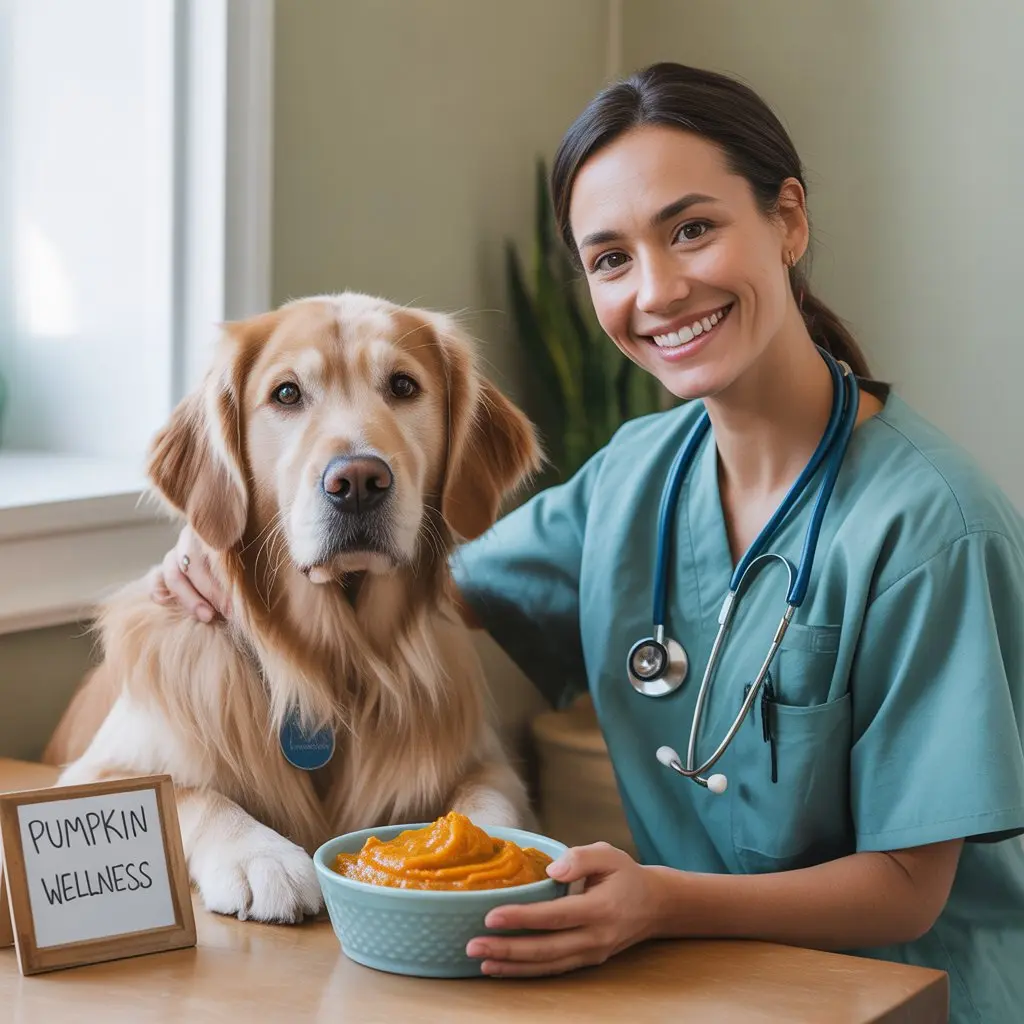
Pumpkin is versatile — you can serve it in simple purees, homemade treats, or even balanced meals. Here are the most popular, vet-approved ways to add pumpkin to your dog’s diet:
1. Pumpkin Puree as a Meal Topper
Easiest option → Mix 1–4 tablespoons of plain pumpkin puree into your dog’s kibble.
Supports digestion, adds moisture, and boosts fiber.
Works well for picky eaters since it’s mildly sweet and palatable.
Switching Foods Too Quickly
Easiest option → Mix 1–4 tablespoons of plain pumpkin puree into your dog’s kibble.
Supports digestion, adds moisture, and boosts fiber.
Works well for picky eaters since it’s mildly sweet and palatable.
2. Pumpkin Dog Treat Recipes
Homemade treats are a fun way to spoil your pup with health benefits.
Baked pumpkin biscuits → Mix pumpkin puree with oat flour and bake.
Frozen pumpkin bites → Blend pumpkin with water or broth, freeze in molds for summer snacks.
3. Pumpkin Mixed with Yogurt or Peanut Butter
Combine pumpkin with plain, unsweetened yogurt → great for gut health (probiotics + fiber).
Blend pumpkin with unsalted, xylitol-free peanut butter → high-value training treat.
Freeze the mix in Kong toys for long-lasting enrichment.
4. Pumpkin in Homemade Dog Food
Use pumpkin as a base ingredient in balanced homemade meals.
Pair with lean proteins (chicken, turkey, fish) and dog-safe carbs (rice, oats).
Provides natural fiber and nutrients without excess calories.
5. Pumpkin Supplements & Commercial Dog Foods
Many commercial dog foods now include pumpkin as a natural fiber source.
Pumpkin-based digestive supplements (powders, chews) offer convenience.
Look for vet-approved brands with no added sugars, spices, or fillers.
Many vets—including those at VCA Animal Hospitals—recommend plain canned pumpkin as a safe, fiber-rich remedy for mild diarrhea in dogs.
Quick takeaway:
Whether you choose puree, treats, or balanced meals, pumpkin is a safe, tasty, and versatile addition to your dog’s diet — as long as it’s plain, natural, and served in moderation.
Quick & Easy Pumpkin Dog Recipes
Whether you choose puree, treats, or balanced meals, pumpkin is a safe, tasty, and versatile addition to your dog’s diet — as long as it’s plain, natural, and served in moderation.
Recipe 1: Frozen Pumpkin-Yogurt Cubes (Summer Treat)
Ingredients:
1 cup plain canned pumpkin puree (no additives)
½ cup plain, unsweetened yogurt
Instructions:
Mix pumpkin and yogurt in a bowl.
Spoon into silicone molds or ice cube trays.
Freeze for 3–4 hours.
Pop out and serve 1–2 cubes as a cooling treat.
Great for gut health + hydration.
Recipe 2: Pumpkin & Oat Biscuits (Crunchy Snack)
Ingredients:
1 cup pumpkin puree
2 cups oat flour (blend oats if needed)
1 egg (for binding)
Instructions:
Preheat oven to 350°F (175°C).
Mix all ingredients into a dough.
Roll out and cut into shapes (bone cookie cutter = cute!).
Bake 25–30 mins until golden brown.
Let cool before serving.
Crunchy, fiber-rich snack that also helps clean teeth.
Bonus Idea: Pumpkin-Peanut Butter Kong Filler
Mix pumpkin puree + unsalted peanut butter → stuff inside a Kong toy → freeze for a long-lasting enrichment treat.
Tip: Always introduce new treats slowly and adjust portions based on your dog’s size.
Pumpkin for Dogs with Specific Health Conditions
1. Constipation & Diarrhea Relief
Pumpkin is rich in soluble fiber, making it a natural remedy for dog constipation and diarrhea. The fiber adds bulk to stools, regulates digestion, and supports a healthy gut.
2. Dogs with Allergies or Food Sensitivities
Plain pumpkin is hypoallergenic and gentle on sensitive stomachs. Many vets recommend pumpkin for dogs with food allergies or sensitive stomachs because it’s low in common allergens and soothing to the digestive system.
3. Diabetes & Obesity
Since pumpkin is low in calories and high in fiber, it makes an excellent weight management aid. Adding pumpkin to meals helps dogs feel full without extra calories. It’s also a safe, low-glycemic snack for dogs with diabetes when served in moderation.
4. Kidney & Liver Issues (Use with Caution)
Dogs with kidney or liver disease often need controlled levels of certain minerals. While pumpkin can be beneficial, it contains potassium and phosphorus, which may not be ideal in high amounts. Always ask your vet before feeding pumpkin to dogs with these conditions.
Vet Tip: Pumpkin should be seen as a supportive food, not a replacement for medical treatment. Always consult your vet before using pumpkin for chronic health problems.
Pumpkin & Dog Health Conditions – Quick Reference Chart
| Dog Health Condition | Pumpkin Use | Notes |
|---|---|---|
| Constipation | Safe & Beneficial | High fiber helps regulate bowel movements. |
| Diarrhea | Safe & Beneficial | Soluble fiber firms loose stools. |
| Food Allergies / Sensitive Stomach | Safe | Gentle, hypoallergenic, soothing to digestion. |
| Obesity / Overweight | Helpful | Low-calorie filler, promotes fullness. |
| Diabetes | Safe in Moderation | Low glycemic index, but check portion size. |
| Joint Health | Supportive | Rich in antioxidants & beta-carotene. |
| Kidney Issues | Caution | Contains potassium & phosphorus—ask vet. |
| Liver Issues | Caution | May not fit restricted diets—consult vet. |
| Pancreatitis | Avoid | Too much fiber/fat may worsen condition. |
| Chronic GI Disorders | Avoid as Sole Treatment | May help symptoms but not a cure—vet care required. |
FAQs About Pumpkin for Dogs
Can dogs eat pumpkin every day?
Yes, in moderation. A small daily serving can support digestion, but too much pumpkin may cause nutrient imbalance.
Can dogs eat raw pumpkin?
No. Raw pumpkin skin and flesh are hard to digest and may cause stomach upset. Always cook or use plain canned pumpkin.
How fast does pumpkin work for dog constipation?
Most dogs show improvement within 12–24 hours after eating pumpkin.
Is pumpkin good for dogs with diarrhea?
Yes. The soluble fiber in pumpkin helps firm up loose stools naturally.
Can puppies eat pumpkin safely?
Yes, in very small amounts. Start with ½–1 teaspoon and check for any tummy upset.
Can dogs eat pumpkin pie filling?
No. It often contains sugar, spices, and nutmeg, which can be toxic to dogs.
How much pumpkin should I feed my dog?
About 1 teaspoon per 10 lbs of body weight, but always adjust to your dog’s size and diet.
Can dogs eat pumpkin seeds?
Yes, if roasted, unsalted, and given in small amounts. They provide protein and healthy minerals.
Is canned pumpkin safe for dogs?
Yes—if it’s 100% pure pumpkin with no added sugar, salt, or spices.
Can pumpkin help dogs lose weight?
Yes. Pumpkin is low in calories and high in fiber, helping dogs feel full without overeating.
Final Verdict: Is Pumpkin Good for Dogs in 2025?
Pumpkin remains one of the safest, most beneficial superfoods for dogs in 2025. It’s packed with fiber, vitamins, and natural antioxidants that support digestion, weight control, and overall health.
When pumpkin helps most: dogs with mild constipation, diarrhea, sensitive stomachs, or weight issues.
When to be cautious: dogs with diabetes, kidney, or liver problems — always consult your vet first.
The key is moderation and balance. Too much pumpkin can cause nutrient imbalance or tummy upset, but the right serving size can be a simple, vet-approved way to keep your pup healthier and happier.
Try adding pumpkin to your dog’s diet today — small spoon, big benefits!



